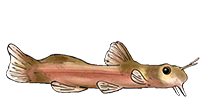Microsynodontis batesii
Microsynodontis batesii
Has anyone here successfully spawned these fish? I have been trying for some time and have not been successful. As near I can, I have tried to duplicate their natural water conditions (Cameroon).
Has anyone else noticed that they form distinct pair bonds and rarely leave their partner?
Michelle
Has anyone else noticed that they form distinct pair bonds and rarely leave their partner?
Michelle
- Silurus
- Posts: 12477
- Joined: 31 Dec 2002, 11:35
- I've donated: $12.00!
- My articles: 55
- My images: 903
- My catfish: 1
- My cats species list: 90 (i:1, k:0)
- Spotted: 433
- Location 1: Singapore
- Location 2: Moderator Emeritus
Are you referring to the true batesii from Cameroon:

or the much smaller Nigerian species (apparently undescribed):

The pair bond observation is interesting. I have what I believe is a pair of the true batesii, but I have never seen them bond much. In fact, they seem somewhat aloof (maybe they're not a pair after all). I also had several of the Nigerian species, but they never seemed to pair up as well.
AFAIK, no successful breeding report exists.

or the much smaller Nigerian species (apparently undescribed):

The pair bond observation is interesting. I have what I believe is a pair of the true batesii, but I have never seen them bond much. In fact, they seem somewhat aloof (maybe they're not a pair after all). I also had several of the Nigerian species, but they never seemed to pair up as well.
AFAIK, no successful breeding report exists.

Mine would be that last picture of the smaller nigerian fish. I wasnt aware that mine was nigerian though. I will double check my water conditions again and make sure I have the right parameters.
We have 3 aquarium club people in my locale actively trying to get these guys spawned. Wish us luck if no one else has been successful yet. I will post if any of us do get fry or even eggs.
We have 3 aquarium club people in my locale actively trying to get these guys spawned. Wish us luck if no one else has been successful yet. I will post if any of us do get fry or even eggs.
I should clarify why I think they are forming pair bonds. Its easy to see the difference between the male and female (my girls look like they are going to burst with eggs and the males are skinny in comparison).
Each female takes a different corner and are never together. I cant tell the difference between the males so they could be switching off. However, the female is always accompanied by a male. When I switched tanks so I could see them better, I saw the same "pair" separate then come back to each other. Males also never seem to be with each other either.
Pair A (the largest female) came from the smae tank and lived with me for 2 months before I got Pair B (smaller female) who had also lived alone for a few months. Maybe its another reason they show a preference for each other. Initially they would have all come from the same shipment.
We are going to separate the fish so there are only 1 pair per tank and see what happens. Can you clarify if these fish will be happy in a pair or if they should be left together as a small group?
Michelle
Each female takes a different corner and are never together. I cant tell the difference between the males so they could be switching off. However, the female is always accompanied by a male. When I switched tanks so I could see them better, I saw the same "pair" separate then come back to each other. Males also never seem to be with each other either.
Pair A (the largest female) came from the smae tank and lived with me for 2 months before I got Pair B (smaller female) who had also lived alone for a few months. Maybe its another reason they show a preference for each other. Initially they would have all come from the same shipment.
We are going to separate the fish so there are only 1 pair per tank and see what happens. Can you clarify if these fish will be happy in a pair or if they should be left together as a small group?
Michelle
- Sid Guppy
- Posts: 757
- Joined: 31 Dec 2002, 15:36
- Location 1: Brabant, the Netherlands
- Interests: Catfish, Tanganyikan fish, Rock'n'roll, Fantasy
These fishes look a LOT like Mochokiella paynee; esp the one on top looks like a streamlined Mochokiella.
Siluris, did you want the fish to make a DNA-map, to see if Mochokiella and Microsynodontis belong in the same genus, perhaps?
Back to post; I've got 4 Mochokiella's (2 pairs, now) and they don't seem to have this pairbonding behaviour. I would leave all four in the same tank; if the bond breaks (it can happen, probably, like with pairbonding cichlids); the aggression still can 'spread out' if you get the picture.
But I hope your fish are in a speciestank; it would be a neat trick, if they spawn; beautiful fish.
did you use timetables too; next to waterparameters? I mean changing the length of day, akin to the seasonal changes? and adding cold rainwater through a sieve or something to simulate rain? Feeding black mosquitolarvae might help too; this seems to work with Syno's (S nigriventris was spawned using this)
Siluris, did you want the fish to make a DNA-map, to see if Mochokiella and Microsynodontis belong in the same genus, perhaps?
Back to post; I've got 4 Mochokiella's (2 pairs, now) and they don't seem to have this pairbonding behaviour. I would leave all four in the same tank; if the bond breaks (it can happen, probably, like with pairbonding cichlids); the aggression still can 'spread out' if you get the picture.
But I hope your fish are in a speciestank; it would be a neat trick, if they spawn; beautiful fish.
did you use timetables too; next to waterparameters? I mean changing the length of day, akin to the seasonal changes? and adding cold rainwater through a sieve or something to simulate rain? Feeding black mosquitolarvae might help too; this seems to work with Syno's (S nigriventris was spawned using this)
Plan B should not automatically be twice as much explosives as Plan A
- Silurus
- Posts: 12477
- Joined: 31 Dec 2002, 11:35
- I've donated: $12.00!
- My articles: 55
- My images: 903
- My catfish: 1
- My cats species list: 90 (i:1, k:0)
- Spotted: 433
- Location 1: Singapore
- Location 2: Moderator Emeritus
No, that wasn't what I wanted the <i>Mochokiella</i> for. Although they appear outwardly similar, there are too many differences in the bone structure to consider them the same genus. However, they do share many characteristics and are most likely most closely related to each other.Siluris, did you want the fish to make a DNA-map, to see if Mochokiella and Microsynodontis belong in the same genus, perhaps?

I do have them in a species tank now although they were in a tank with guppies, young tatia perugiae and pygmy corydoras. Several people have lost the microsynos due to overfeeding- They stuff themselves until they die.
In my fishroom is a second floor bedroom that is south facing so most of my tanks are regulated by natural light but the florescent does come on at night for a while. I also dont heat many of my tanks as daytime make sthis room rather warm (74-76F). These little ones didnt seem to like cooler water at all when I tried. When I got them in the fall they were quite young and I hope that now they are fully mature one of us here will have some luck.
BTW, I am in Northern Canada- no mosquito larvae or rain here! In spring/summer we spray with pesticides and industrial pollution make using rainwater unsafe; even melting snow isnt a good idea. I use RO and frozen bloodworms, grindal or white worms instead.
In my fishroom is a second floor bedroom that is south facing so most of my tanks are regulated by natural light but the florescent does come on at night for a while. I also dont heat many of my tanks as daytime make sthis room rather warm (74-76F). These little ones didnt seem to like cooler water at all when I tried. When I got them in the fall they were quite young and I hope that now they are fully mature one of us here will have some luck.
BTW, I am in Northern Canada- no mosquito larvae or rain here! In spring/summer we spray with pesticides and industrial pollution make using rainwater unsafe; even melting snow isnt a good idea. I use RO and frozen bloodworms, grindal or white worms instead.
- Silurus
- Posts: 12477
- Joined: 31 Dec 2002, 11:35
- I've donated: $12.00!
- My articles: 55
- My images: 903
- My catfish: 1
- My cats species list: 90 (i:1, k:0)
- Spotted: 433
- Location 1: Singapore
- Location 2: Moderator Emeritus
Sorry for the sidetracking, but let me put on a broken record...
Broken record ends, back to <i>Microsynodontis</i>...
Could you please put this in your profile? It's a pet peeve of the mods and admins that there are still members that don't post their location. If we are know where you're at, we can assist you better.BTW, I am in Northern Canada
Broken record ends, back to <i>Microsynodontis</i>...

- Silurus
- Posts: 12477
- Joined: 31 Dec 2002, 11:35
- I've donated: $12.00!
- My articles: 55
- My images: 903
- My catfish: 1
- My cats species list: 90 (i:1, k:0)
- Spotted: 433
- Location 1: Singapore
- Location 2: Moderator Emeritus
Tropical fish are not affected much by the number of hours of daylighht because this does not vary much in their natural environment. The strongest seasonal effects on breeding cycles in tropical freshwater fish are wet/dry seasons, which happens at different times of the year, depending on which part of the tropics you're at.
Knowing your location is still good, as we can suggest what live foods are readily available in your area (or can be easily cultured in your climte), and what fish medications are available to you.
Knowing your location is still good, as we can suggest what live foods are readily available in your area (or can be easily cultured in your climte), and what fish medications are available to you.





